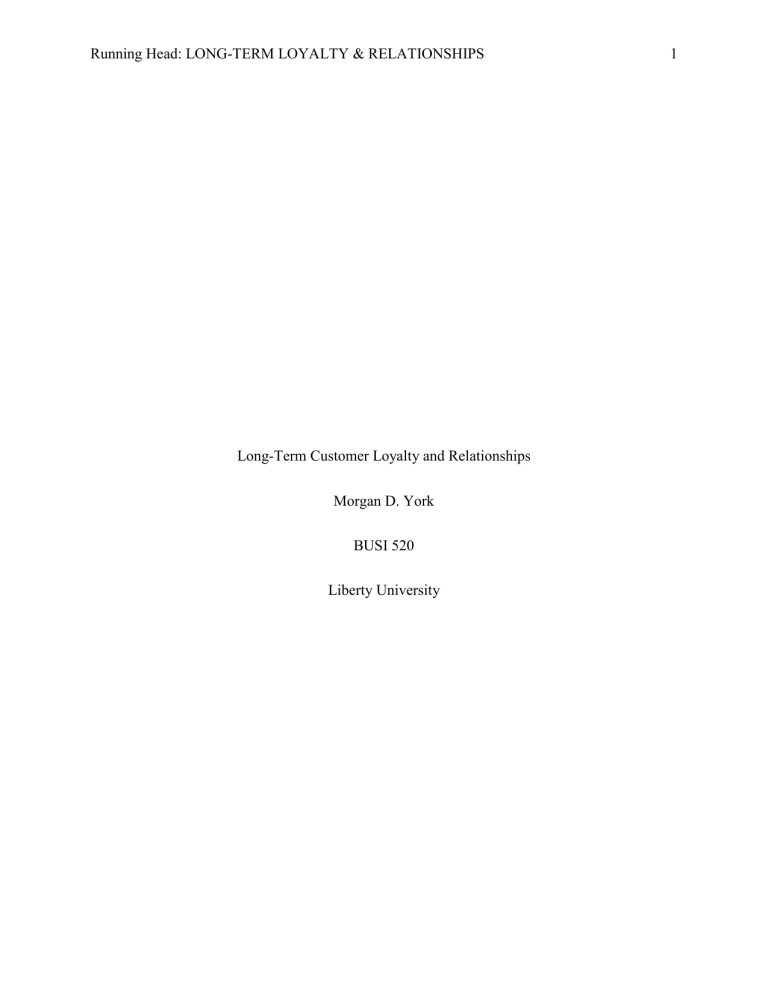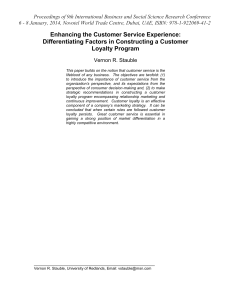
Running Head: LONG-TERM LOYALTY & RELATIONSHIPS
Long-Term Customer Loyalty and Relationships
Morgan D. York
BUSI 520
Liberty University
1
Long-Term Customer Loyalty & Relationships
Long-Term Customer Loyalty
2
When it comes to any company, forming strong and tight connections with their customers is something every company wants. In order to do this successfully, there are numerous activities companies can use to help improve consumer retention and loyalty. Whether companies use retention-building activities or marketing activities, they have a chance at building long-term customer loyalty. The very first thing companies should do if they want to improve their loyalty is by interacting closely with their customers. By connecting your employees with customers, it is seen as both informative and highly motivating. By doing this, employees are forced to listen to customers which is a crucial when it comes to customer relationship management (Kotler & Keller, 2015, p.142-143). But listening to customers is only part of the story when it comes to building long-term customer loyalty.
Another step in building and maintaining customer loyalty is by developing loyalty programs. Frequency programs (FPs) are designed to reward customers that buy regularly and in considerable amounts (Kotler & Keller, 2015, p. 143). While some FPs are a financial burden to offering companies, some seem to be more efficient and creative when it comes to managing them. When companies use frequency programs they are looking to generate rewards in ways that lock customers in by making them feel special which will lead to an increase in customer value. While frequency programs are one option, another loyalty program companies can use is the club membership program. This type of program attracts and keeps customers responsible for the largest portion of a business. With club membership programs companies have the option of having an open or limited membership club. Companies who have limited membership clubs tend to be more powerful when it comes to building long-term customer loyalty (Kotler &
Keller, 2015, p.143).
Long-Term Customer Loyalty & Relationships
Long-Term Customer Relationships
Once a company forms strong and tight connections with their customers then can they use information gathered from their customers to help them enact precise marketing designed to build long-term relationships with their customers. One way this can be done is by using customer relationship management (CRM). CRM according to Kotler and Keller (2015) “is the process of carefully managing detailed information about individual customers and all customer
‘touch points’ to maximize loyalty” (p. 146). Similar to this is customer value management
(CVM) which describes a company’s optimization of the value of its customer basis. While
CRM manages detailed info about their customers and their touch points, CVM focuses on the analysis of individual data on both prospects and customers to help them develop marketing strategies that will help both acquire and retain customers (Kotler & Keller, 2015, p. 146).
After all the information is collected on customers the next thing to do is come up with ways in which customers can be more involved with the company. Some ways this can be done is by market personalization, customer empowerment, customer review and recommendations, and even customer complaints. By both listening to consumer’s needs, marketing based on your consumers, and allowing them to be involved, you are increasing your chances of bringing customers in but most importantly building a relationship with the customers. When an employee can use both individualize and personalize relationships with customers strong bonds will be formed between the customer and the employee (Kotler & Keller, 2015, p. 146).
3
Example of Building Relationships with Customers
Relationship marketing not only is the subject of extensive academic research but it is also practiced by numerous companies. A key factor when building good relationships with
Long-Term Customer Loyalty & Relationships 4 customers is through personalized services, one way to do this is by email. Email has become an essential part of consumers lifestyle. Whether it’s an email with a coupon or an email about a deal, email is the most popular method for learning about new products, services, and promotions. Relationships are easier to develop via email because of a lot of factors. With email you are able to plan out what you want to say, there is no tension and discomfort between the sender and receiver, and you are allowing the receiver to develop their own mental picture.
Because of this, we know that email is a valuable component when it comes to increasing relationships between a company and its customers. Studies have shown that emails are very effective when it comes to enhancing relationship quality, service quality, and even loyalty. The personalization of emails helps influence relationship quality which in the end can lead to better service and loyalty between the consumer and the company (Huang & Shyu, 2009).
Question
How do companies form relationships with their consumers (mainly older consumers) when they do not use email?
Long-Term Customer Loyalty & Relationships
References
Huang, J., & Shyu, S. H. (2009). Building personalised relationships with customers via emails. Total Quality Management & Business Excellence , 20 (6), 585-601.
Kotler, P., & Keller, K. L. (2015). Marketing management (15th ed.).
5




